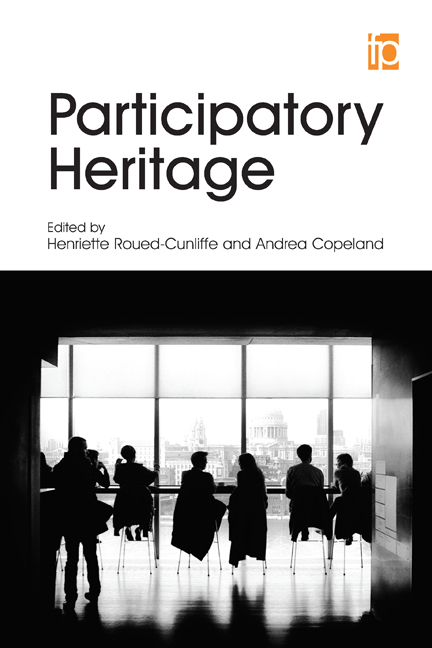Book contents
- Frontmatter
- Contents
- List of figures and tables
- Contributors
- Introduction: what is participatory heritage?
- Part 1 Participants
- Part 2 Challenges
- Part 3 Solutions
- 14 Ethiopian stories in an English landscape
- 15 Having a lovely time: localized crowdsourcing to create a 1930s street view of Bristol from a digitized postcard collection
- 16 Digital archiving in Canadian artist-run centres
- 17 New approaches to the community recording and preservation of burial space
- 18 A case for collaboration: solving practical problems in cultural heritage digitization projects
- 19 Open heritage data and APIs
- Further reading
- Index
19 - Open heritage data and APIs
from Part 3 - Solutions
Published online by Cambridge University Press: 08 June 2018
- Frontmatter
- Contents
- List of figures and tables
- Contributors
- Introduction: what is participatory heritage?
- Part 1 Participants
- Part 2 Challenges
- Part 3 Solutions
- 14 Ethiopian stories in an English landscape
- 15 Having a lovely time: localized crowdsourcing to create a 1930s street view of Bristol from a digitized postcard collection
- 16 Digital archiving in Canadian artist-run centres
- 17 New approaches to the community recording and preservation of burial space
- 18 A case for collaboration: solving practical problems in cultural heritage digitization projects
- 19 Open heritage data and APIs
- Further reading
- Index
Summary
DIGITIZATION OF HERITAGE materials is an important subject within the GLAM (galleries, libraries, archives and museums) sector and as a part of digital humanities (Tanner and Deegan, 2013). Over the past decades many funding opportunities have supported the digitization of heritage materials, understood here in the widest sense as any material related to cultural heritage, from census lists or photos to archaeological finds or first-person accounts. However, questions do occur about the overall impact of digital heritage material and its usefulness to the general public.
As a part of this digitization process we are moving from vast amounts of material in large storage units which are practically ‘lost’ to the public and towards terabytes and petabytes of digital heritage material stored as data. This data can take on different formats, from tabular lists of archaeological finds, to photosets from the 1860s, to a set of co-ordinates illustrating the geographical spread of bygone cultures. Everything has analogue counterparts and the main difference between the analogue and the digital material is the ease with which the latter can be copied and shared across large distances.
To use an analogy from my own experience as a genealogist, it is clear that if I had started family history ten years earlier I would not have had the same successful experience of this hobby that I did. When I began researching my own family history in 2003, in Denmark this still included many trips to local and regional archives. Going to the regional archives usually had to be planned as a day trip and involved standing in line (although more often than not people brought fold-out chairs, coffee and breakfast) until the doors opened. Then there was the rush to get in and get a desk in the reading room. Next you had to hurry to get your orders in for the parish records and special collections. Once this was done you had some waiting time in which you could use the census data available on open shelves.
I went back to the same regional archive in 2015 with a group of students and found it to be a very different experience. No standing in line and no rush to get a desk. Now the only reason to visit the archive is to access special collections, as well as for socializing and getting help from other family historians.
- Type
- Chapter
- Information
- Participatory Heritage , pp. 195 - 204Publisher: FacetPrint publication year: 2017
- 2
- Cited by



